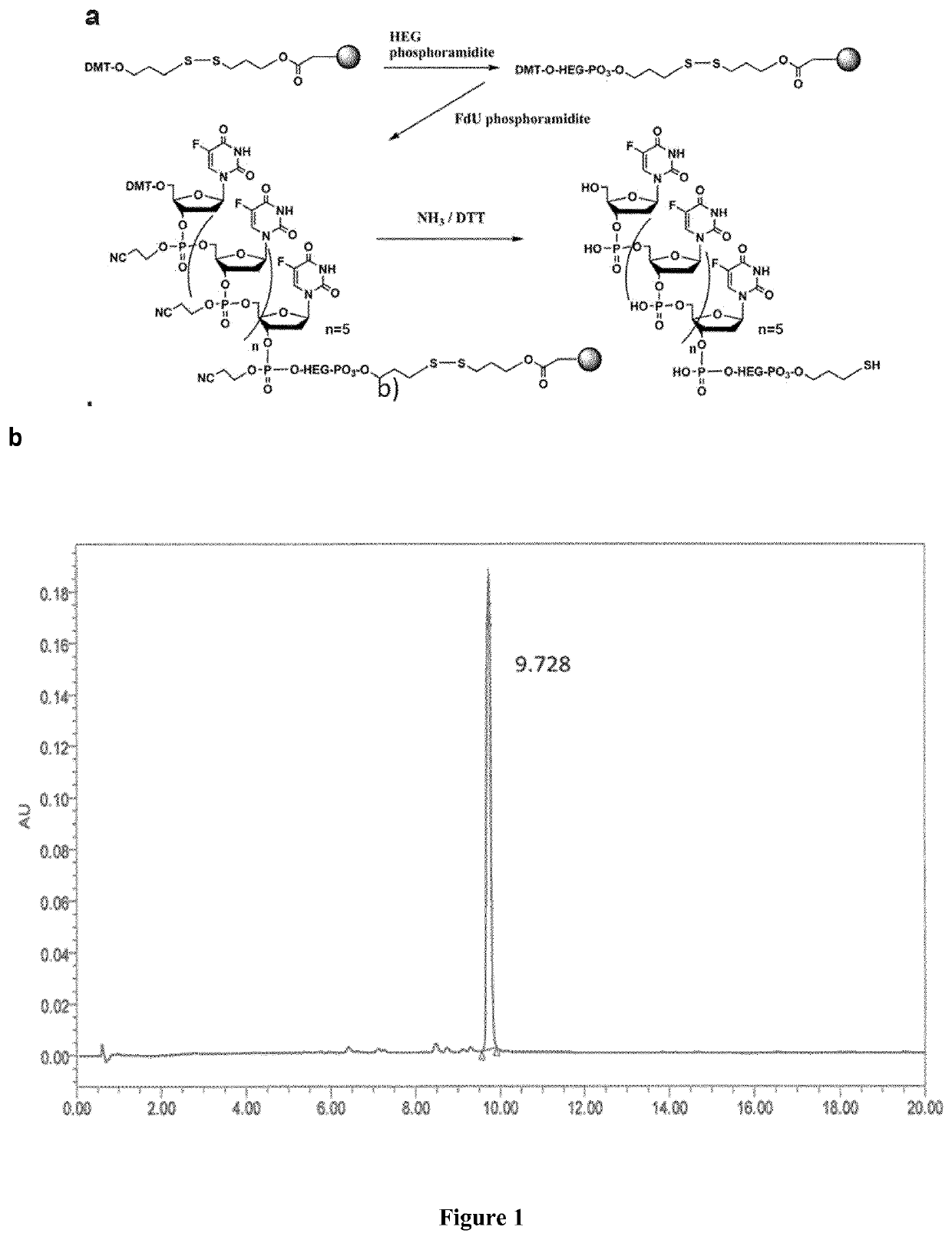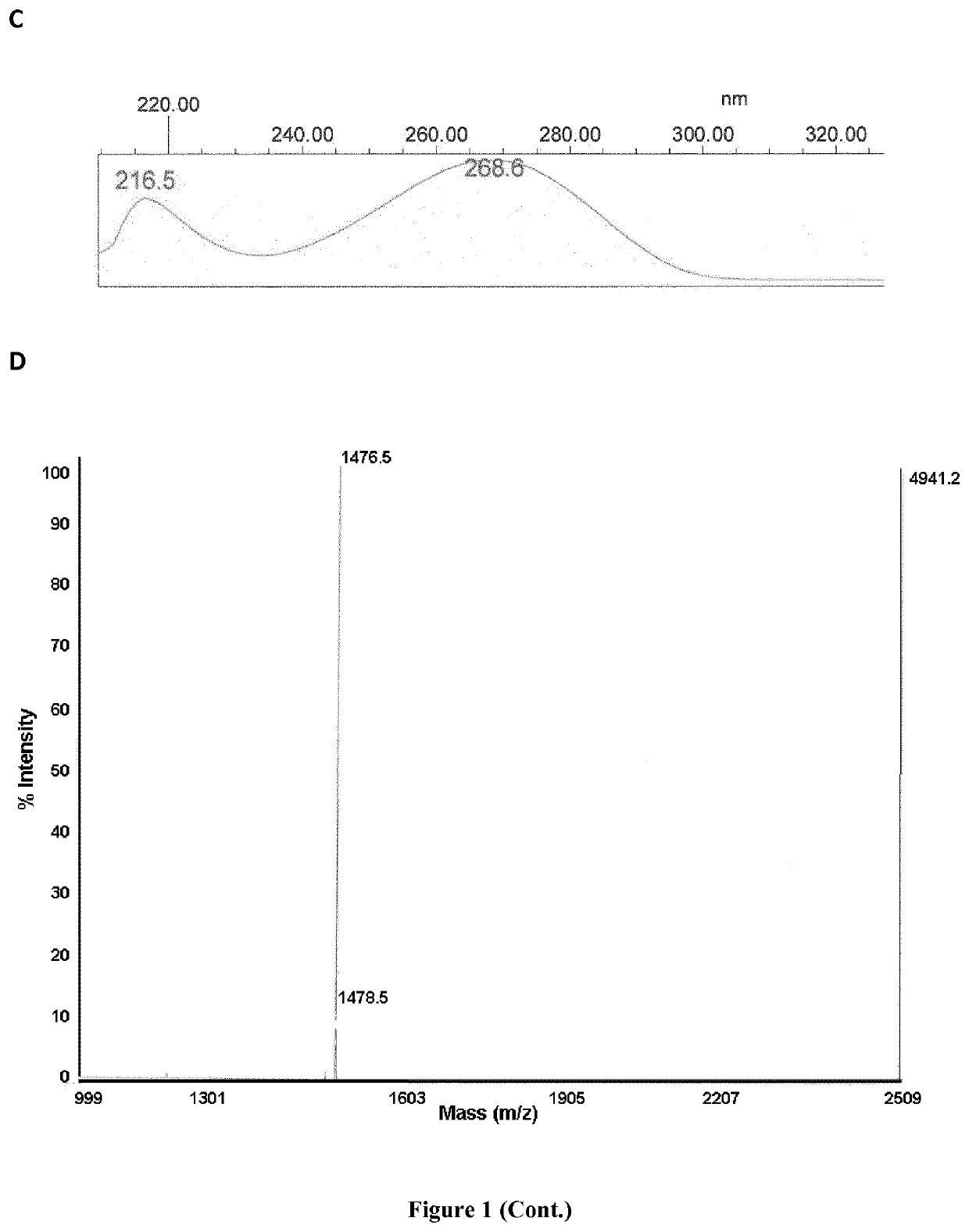Therapeutic nanoconjugates and uses thereof
a technology of nanoconjugates and nanoconjugates, which is applied in the field of nanostructured protein materials to achieve the effect of reducing the cost and synthesis of synthesis and reducing the complexity of antibody structur
- Summary
- Abstract
- Description
- Claims
- Application Information
AI Technical Summary
Benefits of technology
Problems solved by technology
Method used
Image
Examples
example 1
Physicochemical Characterization of HS-oligo-FdU
[0454]The functionalized pentamer FdU-HEG-SH was quantified by absorption at 260 nm and confirmed by MALDI mass spectrometry (MALDI-TOF), yielding a MW of 1976.2, being the expected MW 1974.0. The control pentanucleotide (free oligo-FdU) characterized by mass spectrometry (MALDI-TOF) yield a MW of 1476.5, being the expected MW: 1478.1.
example 2
Physicochemical Characterization of the T22-GFP-H6-FdU Nanoconjugate and Determination of the Drug to Nanoparticle Ratio
[0455]The analysis of the conjugation products was performed by MALDI-TOFF spectra identifying the peaks corresponding to one or two molecules of pentaoligonucleotides of FdU bound to the nanoparticle with the MW indicated in FIG. 2. The T22-GFP-H6-FdU size was determined by dynamic light scattering, being 14.6+0.14, as compared to 13.4+0.11 for the control T22-GFP-H6 nanoparticle, a size consistent with that determined by transmission electron microscopy. The molecular weight of the T22-GFP-H6 nanoparticles, determined by SEC-MALS is of 477 kDa. Considering that the molecular weight of the T22-GFP-H6 polypeptide is of 30,691 kDa, this results in that each nanoparticle has approximately 15 monomers. A drug / nanoparticle ratio of 60 was obtained for the product obtained in the T22-GFP-H6-FdU nanoconjugate synthesis reaction based on the UV spectra of T22-GFP-H6 and T...
example 3
Development of T22-GFP-H6-FdU, a Nanoconjugate that Targets CXCR4+ CRC Cells
[0456]It has been previously demonstrated that CXCR4 overexpressing (CXCR4+) colorectal cancer (CRC) cells have metastasis initiation capacity (MIC) [Croker, A. K. & Allan, A. L. 2008. J Cell Mol Med 12, 374-390; Zhang, S. S. et al. 2012. BMC Med 10, 85 (2012)], and its inhibition by CXCR4 downregulation [Murakami, T. et al. 2012. BMC Med 10, 85; Wang, T. B. et al. 2014. Int J Oncol 44, 1861-1869] identifies these cells as metastatic stem cells (MetSCs). On this basis, the inventors generated a CXCR4-targeted nanoconjugate to evaluate if it could achieve antimetastatic effect by selectively eliminating CXCR4+ CRC cells. The structure and physicochemical characterization of this new T22-GFP-H6-FdU nanoconjugate is described in FIGS. 1, 2 and 4a-c. The conjugate contains T22 (a ligand that targets the CXCR4 receptor), a green fluorescent protein (allowing its in vivo follow-up) and oligo-FdU, an oligonucleotid...
PUM
| Property | Measurement | Unit |
|---|---|---|
| Diameter | aaaaa | aaaaa |
| Diameter | aaaaa | aaaaa |
| Molar density | aaaaa | aaaaa |
Abstract
Description
Claims
Application Information
 Login to View More
Login to View More - R&D
- Intellectual Property
- Life Sciences
- Materials
- Tech Scout
- Unparalleled Data Quality
- Higher Quality Content
- 60% Fewer Hallucinations
Browse by: Latest US Patents, China's latest patents, Technical Efficacy Thesaurus, Application Domain, Technology Topic, Popular Technical Reports.
© 2025 PatSnap. All rights reserved.Legal|Privacy policy|Modern Slavery Act Transparency Statement|Sitemap|About US| Contact US: help@patsnap.com



